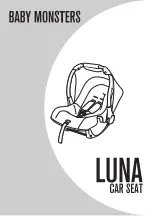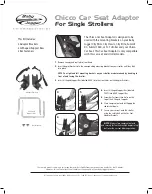
32
31
• Lap/Shoulder belts with a sliding latchplate – Shoulder
belt is mounted on a retractor which automatically pulls the
shoulder belt back in when released as shown in
Figure
38
. Latchplate slides freely along the webbing of the
vehicle belt as shown in
Figure 38a
.
– If this type of lap/shoulder belt is equipped with an
Emergency Locking Retractor (ELR), it may be used.
– If this type of lap/shoulder belt is equipped with an ELR/
ALR Switchable Locking Retractor (SLR), it can be used.
To check if your lap/shoulder belt is equipped with an
SLR:
1. Slowly pull the shoulder belt all the way out until it
stops.
2. Allow the shoulder belt to pull back in about 15 cm
(6”).
3. Pull out on shoulder belt again. If the belt will not pull
out again, it is equipped with a SLR
NOTE:
Some vehicle seat belt systems may have a lap/
shoulder belt equipped with a latchplate which appears to
hold the lap portion at a fixed length when the belt is pulled
tight. This type of lap/shoulder belt is compatible. It may still
have a switchable locking retractor (SLR).
See your vehicle owner’s manual for more information on
installing a child seat using the vehicle belt
.
Figure 38
Figure 38a
Installing/Removing Rear-Facing Car Seat
WARNING — DEATH or
SERIOUS INJURY can occur
• Never use this car seat Rear-Facing in a vehicle front seating location with
an air bag.
• UAS or vehicle belt must be routed through Rear-Facing Belt Path when
using car seat Rear-Facing.
• Anti-Rebound Bar must be used when using seat Rear-Facing.
• UAS or vehicle belt must stay tightly adjusted around car seat at all times.
• Failure to properly install or use this car seat increases the risk of serious
injury or death to the child and others in a sharp turn, sudden stop
or crash.
• Recline Foot must be in the Rear-Facing position when this seat is used
Rear-Facing.
• Seat must be installed within an acceptable recline zone for the child’s
age when using seat Rear-Facing.
• To avoid injury this car seat must be installed by an adult.
















































